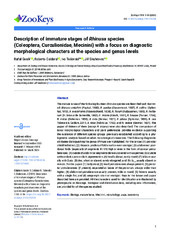Приказ основних података о документу
Description of immature stages of Rhinusa species (Coleoptera, Curculionidae, Mecinini) with a focus on diagnostic morphological characters at the species and genus levels
| dc.creator | Gosik, Rafal | |
| dc.creator | Caldara, Roberto | |
| dc.creator | Toševski, Ivo | |
| dc.creator | Skuhrovec, Jiří | |
| dc.date.accessioned | 2024-03-18T00:01:27Z | |
| dc.date.available | 2024-03-18T00:01:27Z | |
| dc.date.issued | 2024 | |
| dc.identifier.issn | 1313-2989 | |
| dc.identifier.issn | 1313-2970 | |
| dc.identifier.uri | https://plantarum.izbis.bg.ac.rs/handle/123456789/1227 | |
| dc.description.abstract | The mature larvae of the following fourteen Rhinusa species are described and illustrated: Rhinusa antirrhini (Paykull, 1800), R. asellus (Gravenhorst, 1807), R. collina (Gyllenhal, 1813), R. eversmanni (Rosenschoeld, 1838), R. florum (Rubsaamen, 1895), R. herbarum (H. Brisout de Barneville, 1862), R. incana (Kirsch, 1881), R. linariae (Panzer, 1796), R. melas (Boheman, 1838), R. neta (Germar, 1821), R. pilosa (Gyllenhal, 1838), R. rara Toševski & Caldara, 2015, R. tetra (Fabricius, 1792), and R. vestita (Germar, 1821). The pupae of thirteen of them (except R. incana) were also described. The comparison of larval morphological characters and plant preferences provides evidence supporting the existence of different species groups previously established according to a phylogenetic analysis based on adult morphological characters. The following diagnostic attributes distinguishing the genus Rhinusa are highlighted. For the larvae: (1) pronotal shield indistinct; (2) thoracic prodorsal fold small or even vestigial; (3) abdominal postdorsal folds (especially of segments III–VII) high or even in the form of conical protuberances; (4) cuticle of abdominal segments densely covered with asperities; (5) cuticle without dark spots or dark pigmentation; (6) head suboval, rarely round; (7) labrum usually with 2 als; (8) des1 short or absent, rarely elongated; and (9) fs1-3 usually absent or minute. For the pupae: (1) body stout; (2) head protuberances always present; (3) pronotal protuberances (if present), separated at bases of the pronotum, always wider than higher; (4) abdominal protuberance usually present, wide or round; (5) femora usually with a single fes; and (6) urogomphi short or vestigial. Keys to the larvae and pupae described here are provided. All the characters used for identification are illustrated by photographs or drawings. Biological and distribution data, including new information, are provided for all the species studied. | sr |
| dc.language.iso | en | sr |
| dc.publisher | Pensoft Publishers | sr |
| dc.relation | Czech Ministry of Agriculture (Mze ČR) RO0423 | sr |
| dc.relation | info:eu-repo/grantAgreement/MESTD/inst-2020/200010/RS// | sr |
| dc.rights | openAccess | sr |
| dc.rights.uri | https://creativecommons.org/licenses/by/4.0/ | |
| dc.source | ZooKeys | sr |
| dc.subject | Biology | sr |
| dc.subject | mature larva | sr |
| dc.subject | Mecinini | sr |
| dc.subject | morphology | sr |
| dc.subject | pupa | sr |
| dc.subject | taxonomy | sr |
| dc.title | Description of immature stages of Rhinusa species (Coleoptera, Curculionidae, Mecinini) with a focus on diagnostic morphological characters at the species and genus levels | sr |
| dc.type | article | sr |
| dc.rights.license | BY | sr |
| dc.citation.epage | 94 | |
| dc.citation.spage | 1 | |
| dc.citation.volume | 1195 | |
| dc.type.version | publishedVersion | sr |
| dc.identifier.doi | 10.3897/zookeys.1195.112328 | |
| dc.identifier.fulltext | http://plantarum.izbis.bg.ac.rs/bitstream/id/3796/bitstream_3796.pdf |


